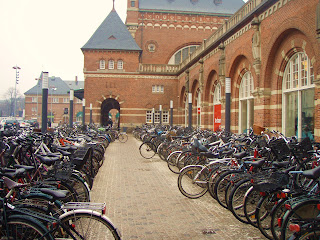It’s no secret that Copenhagen is known for its plethora of bicycles. The benefits of cycling on individuals and communities are numerous and well-documented -- the more interesting question involves how the cycling culture emerged in Denmark and how it is systematically sustained.
Geographically, Copenhagen (and most of Denmark) is flat as a pancake. Good news for A to B travel without getting sweaty or needing a cycling outfit. Historically, Copenhagen has had many jobs tailored to bicycle use and many bicycles modified to suit the jobs available. Home health care, mail and expedited delivery, and mobile food vendors along with WWII gas rations set the stage for bicycle use and civic accommodations. Many jobs in Copenhagen today rely on the bicycle infrastructure, although bicycle messengers are less common with the wide-spread use of electronic transfer of documents.
Currently, mixed-use city districts, and heavy (100-150%) taxation on new vehicles, expensive gasoline ($8/gal), and a fantastic public transportation system all promote the use of cycling as a viable alternative. Bicycles in Copenhagen are ubiquitous, and most parked outside are virtually indistinguishable in design and color. Their closest analogy in US cities is perhaps the shopping cart -- many look just about the same, they are very utilitarian, and you wouldn’t think twice about seeing a cluster of them in any populated area.
There are separate lanes (often with a curb separation from motorized traffic), signal lights, and (un)spoken rules about the cycle traffic. Over %50 of people bike to work in Copenhagen, and when they don’t it is mostly because of poor weather (unlike Salt Lake City, where most folks avoid cycling because of dangerous traffic). The bike lanes even get plowed for snow.
The city even employs a range of high-tech laser rangefinders and accelerometers to measure the bumpiness and ‘comfort factor’ of the dedicated bike lanes and to determine if the cycling surface is too rough. Each bike can be fitted with a computer chip that will help police officers identify stolen bikes with a hand-held scanner (as the former owner of a truck that got stolen, SFPD please take note).
Copenhagen has 2000 ‘City bikes’ that are free to use (with a $3 deposit in self-serve machines) in the summer months. The bikes are painted very obvious gaudy colors and aren’t comfortable enough to take farther than the central city. There is also a hefty fine if you go outside of the city with them.
There is also a strong cycling culture combined with a good dose of national pride in their professional cycling teams. Copenhagen was host to the 2010 World Track Cycling championships, and a full velodrome of spectators knew the Danish athletes by name and thunderously cheered the nuanced (to an outsider, at least) tactics as they raced around the inclined 250m track. I felt a little bit like an American expecting to see the NFL football game at an Irish bar.
Copenhagen’s streets are not small. Parking doesn’t seem more burdensome than it would be in a major US city. The cars in Copenhagen are big by European standards. Cycling isn’t an alternative to when you can‘t drive, driving is the alternative when you can‘t get on your bike.








No comments:
Post a Comment